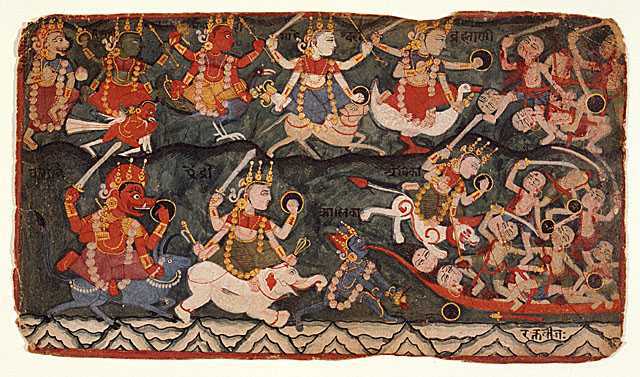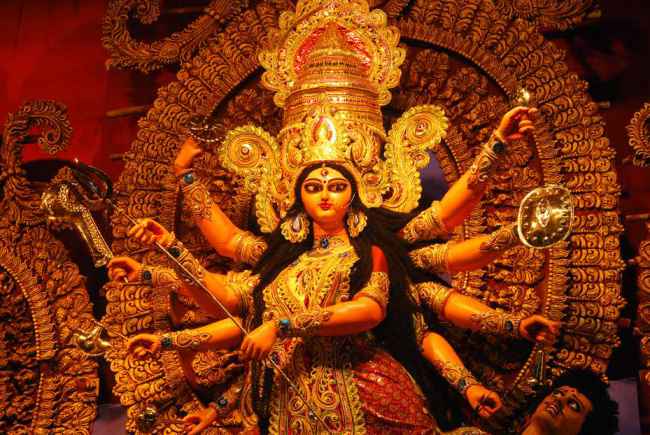No products in the cart.
Devi Mahatmyam describes the story of how Devi (mother Goddess) killed Madhu and Kaidabha as Vishnu Maya (Thamasic-base), killed Mahishasura as Lakshmi (Rajashic form-materialistic) and killed Shumbha and Nishumbha in the form of Goddess Saraswati (Sathvic-spiritual). It is mentioned in the Markandeya purana. Devi Mahatmyam is also known as Saptashti because it contains 700 mantras (7= sapta and 100=ashta.) and 518 verses. There is another opinion that the name should be Saptasati as it deals with the story of seven Satis .The seven mothers are Brāhmi, Māheśwari, Kaumāri, Vaisṇavi, Vārāhi, Indrāṇi, and Cāmunḍa.
One of the important parts of this Holy Scripture is the stories of Markandeya which explain stories that lord Markandeya narrated to Jamini and his students. These stories talk about the brave conquests of the Devi against several demonic forces. The most one that all of us are invariably familiar with is the mahishasura mardini story.
The story of how Durga came into being is quite familiar to all of us. Mahishasura was the most dangerous and evil demons on the face of earth. So the gods decided to give all their powers and weapons to vanquish their enemy. In course of the battle, the demon took several forms including that of a buffalo but Durga Devi slayed his head and brought him under her feet.
Kali is generally associated with great evil and destruction. Kali the dark goddess during her battle with the demon Raktabhija was quite surprised because from every drop of his blood that spilled, another demon arose but goddess Kali would not give up. She drank all the blood of Rakabhija and in frenzy began dancing and it wasn’t until Shiva intervened that she stopped.

Across the Hindu society, the Devi mahatmyam is held with great reverence and bakthi especially during the navaratri pooja which is meant for the worship of the female goddesses or Shakthi. Mahalaya amavasya, which is considered a significant day because all Hindus offer pujas to their ancestors and get their blessings. on this day, the Devi mahatmyam is recited with great belief and respect.
Similar to lord Rudra, there are two forms to the goddess too. One is the nurturing and compassionate mother of the universe and the other the fiery warrior. Both lalitha sahasranamam and Devi mahatmyam are an ode to goddess’s victory over demons. Whilst Lalita sahasranamam describes the victory of the Goddess over Bhandasura, the Devi Mahatmyam describes the victory of the Goddess over the asuras Madhu-Kaitabha, Mahishasura and Shumbha-Nishumbha.
Most of Devi Mahatmyam describes battle scenes and praises of the Devi but even these lines are considered as mantras.
Various forms like Durga, Chandi, Mahakali, Mahalakshmi and Maha Saraswati are but Her divine forms. Each form of the Devi has a distinctive role meant for a definite purpose. Yet every form is also identified as the Ultimate Reality of the universe. Each form of the Divine Mother is thus an embodiment of the Supreme Divinity. One form may appear different from the other. But they are all a manifestation of the supreme Shakti, whom some might call as Brahman or Adi Parashakti.
“Just as the Vedas have no beginning, so is Saptasati considered” — Bhuvaneswari samhita
Though it is actually a part of the markandeya purana, it is given a higher status to that of the purana itself. It is like a collection of mythological stories and hymns in praise of the Devi. The Vedas were not written by a human, they were given by god to the ancient rishis. Often even Devi mahatmyam is associated with this status of revealed knowledge which paves way for the reverence and respect it gets. There are 537 sloka mantras (full slokas), 38 ardha-sloka mantras (half slokas), 66 khanda mantras (part of a sloka), 57 uvacha mantras and 2 punarukta mantras, thus totalling 700 altogether.
The Devi mahtmyam is not just a book of mantras. It poses several philosophical and existential questions about our universe. One has to delve deep in to the purana to understand the different facets of the mantras. It is said that, that even Vishnu knows only three-quarters of the inner sense, Brahma knows half, Veda Vyasa knows only a quarter while others know only a fraction of the true significance of the Devi mahatmyam.
For a layman this purana might seem like the propagation of the nature of god as a female because it talks of the supreme power of the universe as Shakti, but only to those who understand its deep philosophical meaning – the concept that god has no form or nature is evident. Both nirguna and saguna to those who hold on to the physical meaning of the stories, such as multi dimensional approach to understand the deeper meaning of these verses is not possible.
Ancient rishis were tactful in framing all these mantras. Myths are an excellent way to reach the people. At one level they represent just the physical warfare between Shakti and the asuras, at the next level it is symbolic of the battle of life, the constant friction between the failures and successes in life. At a psychological level, the battle is not occurring out in the world but within the mind. There is always a clash between the good and evil thoughts. The evil we are fighting are bad traits such as ego, anger, jealousy etc.
The Devi Mahatmyam has the ability to grant the fruits as per the upasana. A sakama upasaka (one who does sadhana with a specific desire or goal in mind) achieves whatever he aspires for while a nishkama upasaka (one who does sadhana without any expectation or desire) achieves moksha. The stories of Devi Mahatmyam are as told by Sage Markandeya to Sage Baguri. He tells him that one king called Suradha, who was driven out of his kingdom by his own people met one Vysya (businessman) called Samadhi who was driven out of his home by his wife and sons, in the forest. They discover that though their own people have driven them out, they are both worried about the welfare of their people. It appears to them that this is unnatural. So they approach Sage Sumedhas who was also living in the forest. The sage tells them that all this is the illusion created by the great Goddess called Vishnu Maya. They became curious and want to know about this great mother Goddess. He then relates to them the story of Devi Mahatmyam, which consists of three stories in all of which the mother Goddess kills the enemies of Gods.
Suratha the king was bestowed with unmixed prosperity whereas the merchant Samadhi was conferred with divine knowledge according to their own aspirations. If Sri Candi is pleased, she confers on her devotees both earthly prosperity and supreme knowledge
सर्वमङ्गलमाङ्गल्ये शिवे सर्वार्थसाधिके ।
शरण्ये त्र्यम्बके गौरि नारायणि नमोऽस्तु ते ॥
this is the beginning of the Devi mahatmya which translates to
” oh narayani Who is the Auspiciousness in All the Auspicious, Auspiciousness Herself, Complete with All the Auspicious Attributes, and Who fulfills All the Objectives of the Devotees (Purusharthas – Dharma, Artha, Kama and Moksha)”
Here are two methods to start reading Devi Mahatmym – Trayangam and Navangam.
Trayangam is a method in which we need to chant three prayers – Devi Kavacham, Argala Stotram and Devi Keelakam followed by Navakshari Mantram.Navangam is a method for which nine prayers are recited prior of starting reading the book. Navangam stotrams are: Devi Nyasa, Devi Avahana, Devi Namani, Argala Stotram, Keelaka Stotram, Devi Hrudaya, Dhala, Devi Dhyana and Devi Kavacha.As per the prescribed methods in ancient scriptures, Devi Mahatmyam should be read in one sitting. After finishing the recital of Devi Mahatmyam, one should chant the Devi Suktam (slokas 7 to 36 of Chapter 8).
Reciting Devi mahatmyam during navaratri is considered as highly auspicious,
1st day: Chapter 1 (Madhu kaitabha samhaaram)
2nd day: Chapter 2, 3 and 4 (Mahishhasura samhaara)
3rd day: Chapter 5 and 6 (Dhuumralochana vadha)
4th day: Chapter 7 (Chanda Munda vadha)
5th day: Chapter 8 (Rakta biija samhaara)
6th day: Chapter 9 and 10 (Shumbha Nishumbha vadha)
7th day: Chapter 11 (Praise of Narayani)
8th day: Chapter 12 (Phalastuti – reciting merits or benefits)
9th day: Chapter 13 (Blessings to Suratha and the Merchant)
10th day: Chapter 14 (Aparadha Kshamaprarthana) on 10th day
You can also complete the recital on 9th day by chanting Devi Aparadha Kshama Prarthana Stotram on 9th day itself.
You should read Siddha Kunjika Stotram after completing the recital of every chapter.
There are specified methods and traditions one must follow while reciting the Devi mahatmyam it appeals to the supreme force of the universe shakthi in its rudra form. Worship of god in the form of feminine power has been prevalent in our society for ages. There have been several literary works in praise of the several goddesses in Hinduism, the Devi mahatmyam is the pinnacle of such texts.
Devi Mahatmyam






